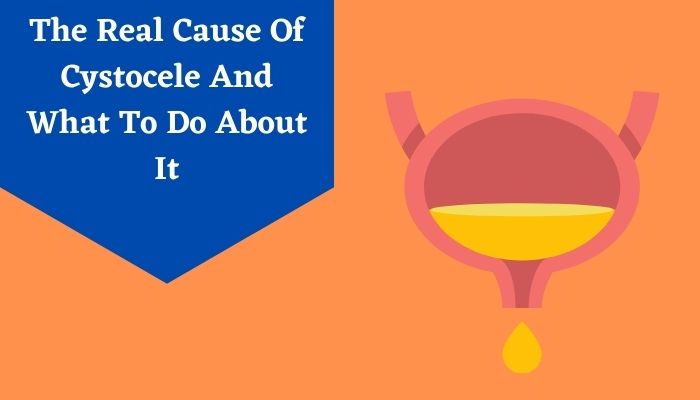Knowing about the real cause of Cystocele is essential if you wish to fix the issue once and for all. There are various symptoms of the ailment that you should also keep in mind. Cystocele is a condition characterized by the weakening of the wall between the vagina and bladder.
| Name of the Condition: Cystocele |
| Types: Grades 1, 2, 3 |
| More Likely to Have: Women of almost any age, especially those giving birth vaginally |
| Cause: Obesity, Age, ChildBirth, Heavy Lifting, Chronic Coughing, etc. |
Learning More About Cystocele
What do we mean by Cystocele? You must have heard of the terms Cystocele and Rectocele. The former, as mentioned, is a condition where the wall separating the vagina and bladder starts weakening. It may start sagging or dropping into the vagina as a result. This results from the weakening and stretching of supportive tissues in the area, enabling the vaginal wall and bladder to drop into the vaginal canal. One of the biggest Cystocele symptoms is when the uterus or vaginal walls start losing their usual support or bulging into the vaginal canal. Other organs like the bowel or bladder may also change positions as a result.There are three types of Cystocele, namely Grades 1, 2, and 3. Grade 1 indicates that the bladder has only slumped a little into the vaginal canal. Grade 2 is when the bladder has slumped into the vagina by a long way, reaching the opening. Grade 3 indicates the most advanced stage, i.e. a bulging bladder through the vaginal opening.
Some Other Facts About Cystocele
- Cystocele is one of the commonest disorders affecting women. The condition often goes neglected since it does not exactly come with external symptoms in most cases.
- Women of any age may be impacted by this condition, although aging increases the risks of weaker body tissues and muscles alike.
- Other factors that enhance risks include a history of pelvic surgery including hysterectomy or pelvic organ prolapse repair surgery for instance.
- Some additional risk factors include giving vaginal birth, obesity, and a family history of what doctors call pelvic organ prolapse.
Causes Behind Cystocele
- Aging
- Obesity
- Giving birth to a child
- Chronic coughing
- Lifting heavy things
- Straining the body muscles at the time of giving birth
- Strain at the time of bowel movements
- Constipation
- Earlier pelvic surgeries
- Weaker muscles surrounding the vagina
Symptoms of Cystocele
- Heavy feeling around the pelvic area.
- A bulge within the vaginal canal can be felt.
- Pain the lower back.
- Feeling pressure in the pelvis/lower belly or any body aches.
- Infections of the urinary tract.
- Urine leakage.
- Need for frequent urination.
- Painful intercourse.
- Not emptying the bladder completely.
- Pressure on the pelvis increases with coughing, lifting things, standing up, and so on.
Diagnosis
1. Urodynamics
Tests for Cystocele may include urodynamics, the testing group for assessing the functioning of the bladder, and also pelvic examinations.2. Vaginal Pessary
Women sometimes choose vaginal pessary, which is a device for enhanced support. It is put into the vagina for this purpose.3. MRI Scans
Tests may also include MRI scans for working out the exact bladder prolapse situation and Cystourethrogram or voiding cystogram which is basically a bladder X-ray taken at the time of urination, with the urethra and bladder filled up with contrast dye.Treatment
1. Surgery
Advanced levels of Cystocele may necessitate surgery.2. Avoid Lifting Heavy Objects
Cystocele treatment at a basic level involves avoiding lifting heavy things and workouts that may lead to worsening of the conditions.3. Avoid Kegel Exercises
Doctors may also advise regular Kegel exercises to strengthen the pelvic muscles.4. Hormonal Replacement Therapy
Hormone replacement therapy is recommended at times, for enhancing the strength of the muscles around the bladder and vagina.5. Anterior Vaginal Repair
The commonest surgical procedure for repairing this issue is anterior vaginal repair or anterior colporrhaphy as it is also called. As a part of treatment, the surgeon will put the bladder into its regular position while tightening the tissues and muscles holding the bladder in position with stitches.5. Obliterative Surgery
Obliterative surgery is also used for closing off or narrowing the entire vagina or a portion of the same, ensuring greater bladder support. However, post this surgery, women cannot have intercourse any longer.The doctor may also recommend another medical treatment for combating urinary incontinence simultaneously with the surgery.
Keeping Cystocele at Bay
You can always lower your risks of Cystocele by adopting the following measures:- Regular exercises of the pelvic floor muscles will help the pelvic organs stay in their positions. Kegel exercises are often recommended by doctors for strengthening the pelvic muscles.
- Try and maintain a healthy weight ratio since obesity or heavy weight may put increasing pressure on the pelvis. Change your daily lifestyle patterns and eating habits, consume more vegetables and fruits, and also exercise on a regular basis.
- Do not lift heavy things or engage in weight lifting. Use your legs instead of your back and waist if you have to lift something heavy.
- Keep constipation away and treat it as much as needed. Consume sufficient fiber every day, drink water and other fluids and stay physically active above all else.
- Combat chronic coughing with the right medicines and treatment. Avoid smoking by all means.



